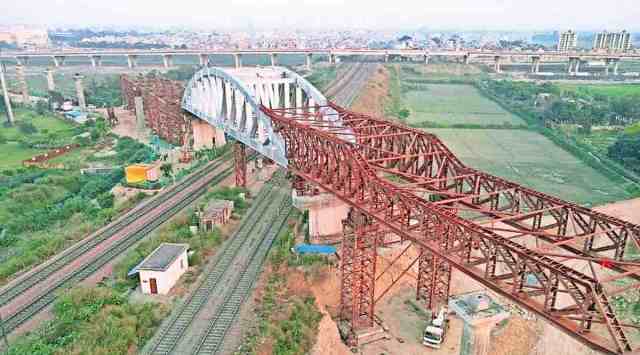- India
- International
RRTS to replace over one lakh private vehicles, cut CO2 emissions
🔴 As per officials, the corridor will start from Sarai Kale Khan in Delhi, pass through Ghaziabad, and reach Modipuram in Meerut. The RRTS, the first of its kind in the national capital, will run at a speed of 100 km per hour and commuters will reach Meerut in 50-60 minutes.
 The corridor will start from Sarai Kale Khan in Delhi, pass through Ghaziabad, and reach Modipuram in Meerut. (Express)
The corridor will start from Sarai Kale Khan in Delhi, pass through Ghaziabad, and reach Modipuram in Meerut. (Express)Work on the 82-km Rapid Rail Transit Corridor (RRTS) connecting Delhi to Meerut is in full swing, with the 17-km priority section from Ghaziabad to Duhai to be ready by 2023. Once fully operational, officials estimate that it will reduce CO2 emissions by taking around 1.5 lakh private vehicles off the road.
“The corridor is estimated to reduce 2.5 lakh CO2e/year of total annual greenhouse gas emissions, making the city a cleaner and a much better place to live. It is also estimated to increase the share of public transportation usage along the corridor from 37% to 63%. It will further take more than 1 lakh private vehicles off the road and help decongest the NCR, which lacks a public transport system,” said a senior official of the National Capital Region Transport Corporation (NCRTC).
As per officials, the corridor will start from Sarai Kale Khan in Delhi, pass through Ghaziabad, and reach Modipuram in Meerut. The RRTS, the first of its kind in the national capital, will run at a speed of 100 km per hour and commuters will reach Meerut in 50-60 minutes. The trains will further have separate business coaches and general coaches.
Where work stands
About 14-km of the RRTS falls in Delhi and passes through Sarai Kale Khan, Jangpura, Anand Vihar and New Ashok Nagar. These stations will serve as key interchanges to Metro stations, ISBTs and other RRTS corridors.

Of the 14 km stretch, 9.2 km will be elevated while the Anand Vihar portion will be underground. “Foundation work, including piling and pile caps for the elevated section, is in full swing between New Ashok Nagar and Kondli. Work is done on a 3-km stretch; piers are being erected on portions where foundation work is completed,” said a senior NCRTC official.
Following massive utility shifting/modification for the Sarai Kale Khan station in Delhi, work on laying the foundation and pier construction is on. At this station, all three corridors of RRTS Phase-I – Delhi-Meerut, Delhi-Alwar and Delhi-SNB – will merge and serve as an interchange facility for the rapid rail, railway station, metro station and ISBT.
Currently, people have to exit and walk over a kilometre or take a rickshaw to reach the railway station or bus stand. Once the RRTS is completed, they can avail the interchange facility without exiting the premises.
At Jangpura, to facilitate public access to the RRTS station, a four-lane underpass has been constructed from Mathura Road towards the station. Work on the other stations of Delhi is also progressing rapidly.
New Ashok Nagar, which is an elevated station, will provide interchange facilities with the nearby Metro station. At Anand Vihar, preparations are on to launch a tunnel boring machine to construct underground parts of the corridor, said the official.
Besides, the NCRTC is also constructing a 1.35-km-long bridge over the Yamuna in Delhi, almost parallel to the existing DND flyway. This will connect the Sarai Kale Khan and New Ashok Nagar RRTS stations.
The length of the bridge over the river will be around 626 meters and the rest will be over the khadar area on both sides. It will have 32 piers; spans over these piers will be 44 metres. Work on laying the foundation for the bridge is underway.
“NCRTC has completed about 80% of the foundation work of the elevated section. More than 1,200 piers have been constructed on a 30-km stretch, out of 82 km. About 16-km of the viaduct has been constructed, most of which is located on the priority section,” said the official. The priority section starting from Sahibabad to Duhai Depot in Ghaziabad will have a total of 5 stations and are nearing completion.
Apr 24: Latest News
- 01
- 02
- 03
- 04
- 05







































